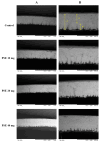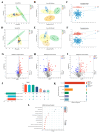Effects of Phytosterol Ester Supplementation on Egg Characteristics, Eggshell Ultrastructure, Antioxidant Capacity, Liver Function and Hepatic Metabolites of Laying Hens during Peak Laying Period
- PMID: 38671906
- PMCID: PMC11047565
- DOI: 10.3390/antiox13040458
Effects of Phytosterol Ester Supplementation on Egg Characteristics, Eggshell Ultrastructure, Antioxidant Capacity, Liver Function and Hepatic Metabolites of Laying Hens during Peak Laying Period
Abstract
The aim of this experiment was to investigate the effects of dietary Phytosterol Ester (PSE) supplementation on egg characteristics, eggshell ultrastructure, antioxidant capacity, liver function, hepatic metabolites, and its mechanism of action in Hy-Line Brown laying hens during peak laying period. A total of 256 healthy Hy-Line Brown laying hens were randomly allocated into four groups. The hens in the control group were fed a basal diet, while those in the experimental groups were fed a basal diet further supplemented with 10, 20, and 40 mg/kg PSE, respectively. It was found that the addition of 20 mg/kg and 40 mg/kg PSE to the diets increased egg weight, but decreased egg breaking strength (p < 0.05). The addition of PSEs to the diets increased albumen height and Haugh unit in all experimental groups (p < 0.05). Electron microscopic observation revealed that the mammillary thickness increased significantly at doses of 20 and 40 mg/kg, but the total thickness decreased, and the effective thickness also thinned (p < 0.05). The mammillary width narrowed in all experimental groups (p < 0.001). Dietary supplementation with 40 mg/kg PSE significantly increased egg yolk Phenylalanine, Leucine, and Isoleucine levels (p < 0.05). In untargeted liver metabolomic analyses, L-Phenylalanine increased significantly in all experimental groups. Leucyl-Lysine, Glutamyl-Leucyl-Arginine, and L-Tryptophan increased significantly at doses of 10 and 20 mg/kg (p < 0.05), and L-Tyrosine increased significantly at doses of 10 and 40 mg/kg (p = 0.033). Aspartyl-Isoleucine also increased significantly at a dose of 10 mg/kg (p = 0.044). The concentration of total protein in the liver was significantly higher at doses of 20 and 40 mg/kg than that of the control group, and the concentrations of total cholesterol and low-density lipoprotein cholesterol were significantly reduced (p < 0.05). The concentration of triglyceride and alkaline phosphatase were significantly reduced in all experimental groups (p < 0.05). Steatosis and hemorrhage in the liver were also improved by observing the H&E-stained sections of the liver. Concerning the antioxidant capacity in the liver, malondialdehyde concentration was significantly reduced (p < 0.05) at a dose of 40 mg/kg. In the ovary, malondialdehyde and nitric oxide concentrations were significantly reduced (p < 0.001). In all the experimental groups, plasma nitric oxide concentration was significantly decreased while superoxide dismutase was significantly increased, and total antioxidant capacity concentration was significantly increased (p < 0.05) in the 10 mg/kg and 40 mg/kg doses. Metabolomics analyses revealed that PSEs play a role in promoting protein synthesis by promoting Aminoacyl-tRNA biosynthesis and amino acid metabolism, among other pathways. This study showed that the dietary addition of PSEs improved egg characteristics, antioxidant capacity, liver function, and symptoms of fatty liver hemorrhagic syndrome in Hy-Line Brown laying hens at peak laying stage. The changes in liver metabolism suggest that the mechanism of action may be related to pathways such as Aminoacyl-tRNA biosynthesis and amino acid metabolism. In conclusion, the present study demonstrated that PSEs are safe and effective dietary additives as an alternative to antibiotics.
Keywords: antioxidant capacity; egg characteristics; eggshell ultrastructure; hepatic metabolomics; liver function; phytosterol esters.
Conflict of interest statement
The authors declare no conflicts of interest.
Figures




Similar articles
-
Effects of phytosterol ester supplementation on egg weight, biochemical indices, liver immunity and gut microbiota of laying hens during peak laying period.Poult Sci. 2024 Dec;103(12):104305. doi: 10.1016/j.psj.2024.104305. Epub 2024 Sep 13. Poult Sci. 2024. PMID: 39316984 Free PMC article.
-
Grape Pomace: Agrifood By-Product with Potential to Enhance Performance, Yolk Quality, Antioxidant Capacity, and Eggshell Ultrastructure in Laying Hens.Vet Sci. 2023 Jul 13;10(7):461. doi: 10.3390/vetsci10070461. Vet Sci. 2023. PMID: 37505865 Free PMC article.
-
Effect of exogenous bile salts supplementation on the performance and hepatic lipid metabolism of aged laying hens.J Anim Sci. 2023 Jan 3;101:skad334. doi: 10.1093/jas/skad334. J Anim Sci. 2023. PMID: 37773415 Free PMC article.
-
Dietary cadmium chloride impairs shell biomineralization by disrupting the metabolism of the eggshell gland in laying hens.J Anim Sci. 2020 Feb 1;98(2):skaa025. doi: 10.1093/jas/skaa025. J Anim Sci. 2020. PMID: 31974567 Free PMC article.
-
Protective effect of Artemisia capillaris on hepatic lipid accumulation in laying hens with fatty liver and the study of its mechanism.Br Poult Sci. 2025 Jun 9:1-12. doi: 10.1080/00071668.2025.2512585. Online ahead of print. Br Poult Sci. 2025. PMID: 40488218 Review.
Cited by
-
Effects of phytosterol ester supplementation on egg weight, biochemical indices, liver immunity and gut microbiota of laying hens during peak laying period.Poult Sci. 2024 Dec;103(12):104305. doi: 10.1016/j.psj.2024.104305. Epub 2024 Sep 13. Poult Sci. 2024. PMID: 39316984 Free PMC article.
-
Effects of various supplemental levels of multi-enzyme complex on amino acid profiles in egg yolk, antioxidant capacity, cecal microbial community and metabolites of laying hens.Front Microbiol. 2024 Nov 28;15:1466024. doi: 10.3389/fmicb.2024.1466024. eCollection 2024. Front Microbiol. 2024. PMID: 39669781 Free PMC article.
References
-
- Miao Y.F., Gao X.N., Xu D.N., Li M.C., Gao Z.S., Tang Z.H., Mhlambi N.H., Wang W.J., Fan W.T., Shi X.Z. Protective Effect of the New Prepared Atractylodes Macrocephala Koidz Polysaccharide on Fatty Liver Hemorrhagic Syndrome in Laying Hens. Poult. Sci. 2021;100:938–948. doi: 10.1016/j.psj.2020.11.036. - DOI - PMC - PubMed
-
- Yang F., Ruan J.M., Wang T.C., Luo J.R., Cao H.B., Song Y.L., Huang J.Z., Hu G.L. Improving Effect of Dietary Soybean Phospholipids Supplement on Hepatic and Serum Indexes Relevant to Fatty Liver Hemorrhagic Syndrome in Laying Hens. Anim. Sci. J. 2017;88:1860–1869. doi: 10.1111/asj.12832. - DOI - PubMed
-
- Duan Q.B., Yu P.T. Causes and control measures of sudden death syndrome in broilers. Modern Rural Sci. Technol. 2019;6:41.
Grants and funding
LinkOut - more resources
Full Text Sources

